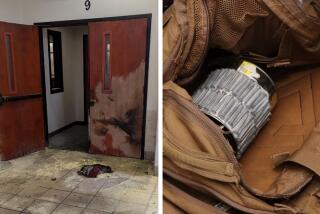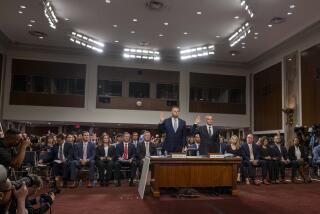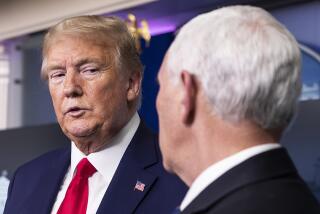McVeigh Assassination Fears Described
- Share via
DENVER — A senior FBI official testified Wednesday that law enforcement authorities feared someone might try to assassinate Timothy J. McVeigh shortly after he was arrested in the Oklahoma City bombing.
Special Agent James Adams, the second-in-charge at the FBI’s command post in Oklahoma City in the days after the April 1995 bombing, said officials were concerned that someone upset over the deaths of the 168 people killed in the disaster might be angry enough to try to shoot McVeigh as agents led him out of a small-town courthouse after he was arrested.
But Adams also acknowledged that he ordered agents to escort McVeigh out of the courthouse in a bright orange jumpsuit. And, he said, he never considered giving McVeigh a bulletproof vest to wear as he was walked past a large, angry crowd shouting epithets as the nation got its first look at the man charged in the worst terrorist attack in U.S. history.
“We were concerned about an assault with a rifle,” Adams said. “But the bulletproof vests we have don’t stop a rifle shot and, quite frankly, I didn’t even think about using a bulletproof vest.”
Adams testified in federal court here in the second day of a preliminary hearing about whether certain government eyewitnesses should be allowed to testify at McVeigh’s trial, which begins in six weeks.
Defense attorneys said that the McVeigh “walk-out” from the Noble County courthouse in Perry, Okla., near where he had been arrested, became a major media event played over and over on television. They argued that many of the eyewitnesses later fit their descriptions of McVeigh to match the way he looked that day.
But government prosecutors contended otherwise. When the FBI realized that McVeigh--who was in the county courthouse on an unrelated state charge--was the prime suspect in the bombing, agents worked to expedite a federal arrest warrant against him and then to get him safely out of Perry and to a federal prison near Oklahoma City, they said.
“The FBI was concerned about that and they took steps to make sure that he was as well-protected as possible,” said Aitan Goelman, an assistant government prosecutor.
“They picked the safest door possible. They surrounded him with agents who were so close that they were almost touching him” and exposed him for a minimal amount of time, he said.
Goelman denied that the walk-out was “some sort of publicity stunt” to boast to the nation that the FBI had arrested the chief suspect just two days after the bombing. “There isn’t a shred of evidence to support that,” he said.
The bombing of the Alfred P. Murrah Federal Building occurred on April 19, 1995, and McVeigh was identified as the key defendant on April 21. McVeigh’s lawyers said that the volatile scene outside the Noble County courthouse that day not only jeopardized his safety but also made a media spectacle of the arrest for a nation hungry for swift justice.
“Of course it wasn’t safe,” said Stephen Jones, McVeigh’s lead attorney, criticizing the government’s contention that everything was done to protect his client.
Jones also said that while national polls show that 95% of the American public has seen the videotape of the McVeigh walk-out, the government’s eyewitnesses testified that they never saw video of the event or--if they did--that it did not influence their recollections of McVeigh and his activities in the period before the bombing.
“Amazingly enough, we have a situation here today in which almost none of these witnesses watched,” Jones said.
He is asking Judge Richard P. Matsch to bar the eyewitnesses from testifying at McVeigh’s trial. The hearing continues today.
More to Read
Sign up for Essential California
The most important California stories and recommendations in your inbox every morning.
You may occasionally receive promotional content from the Los Angeles Times.











